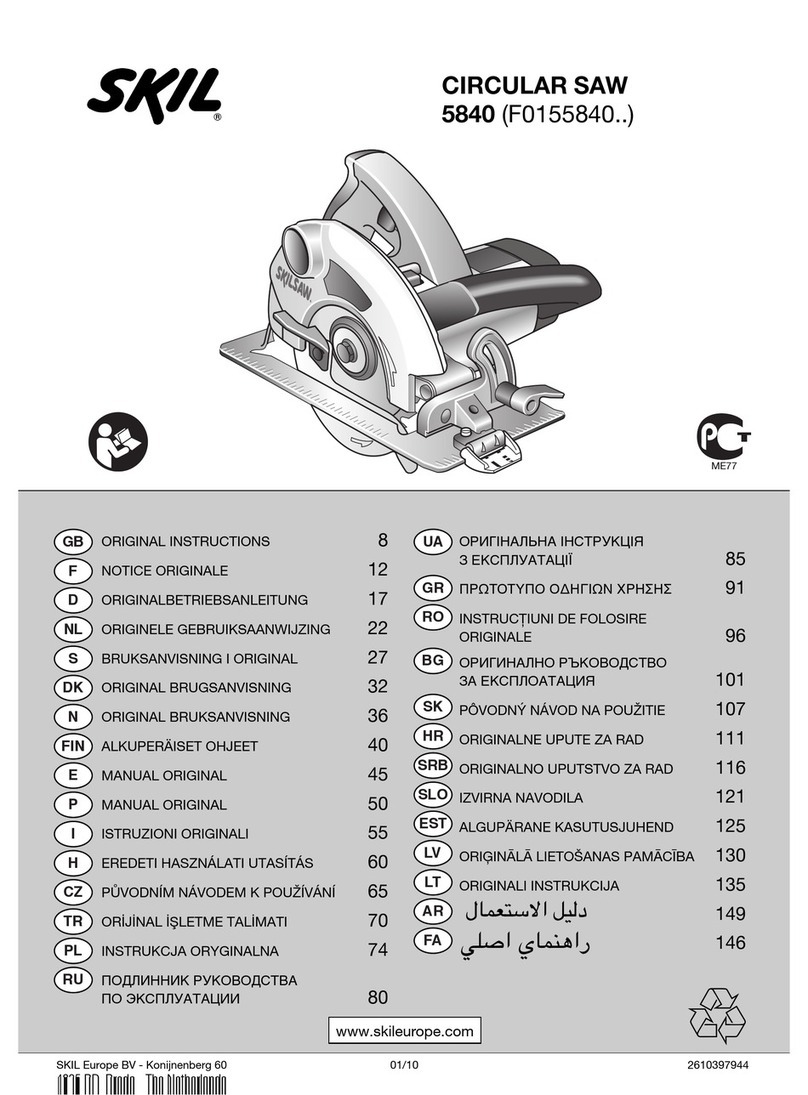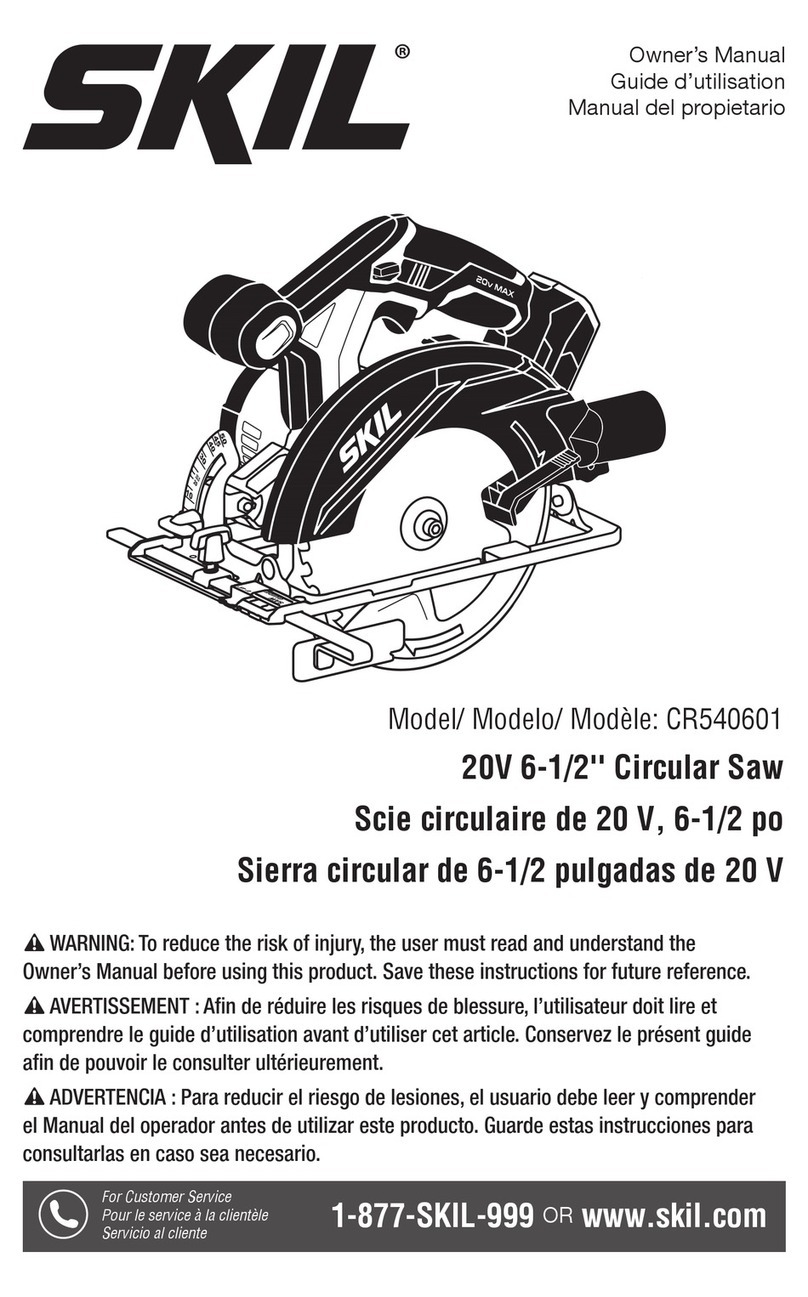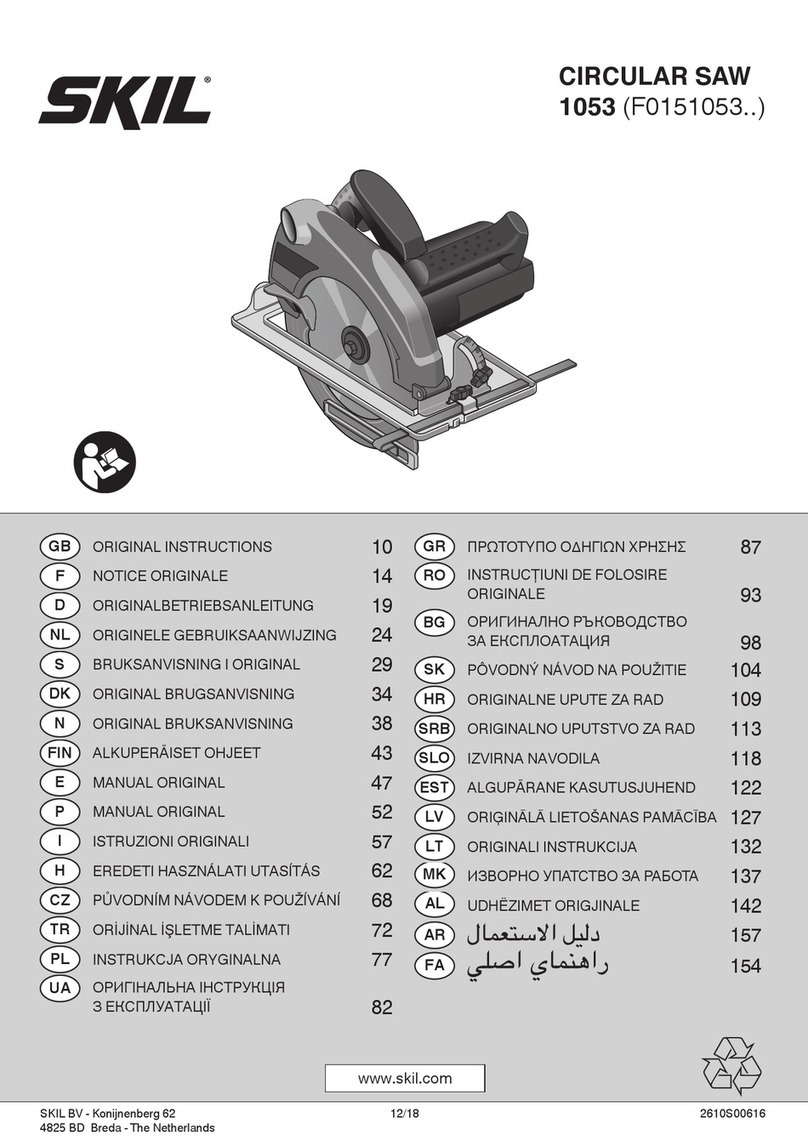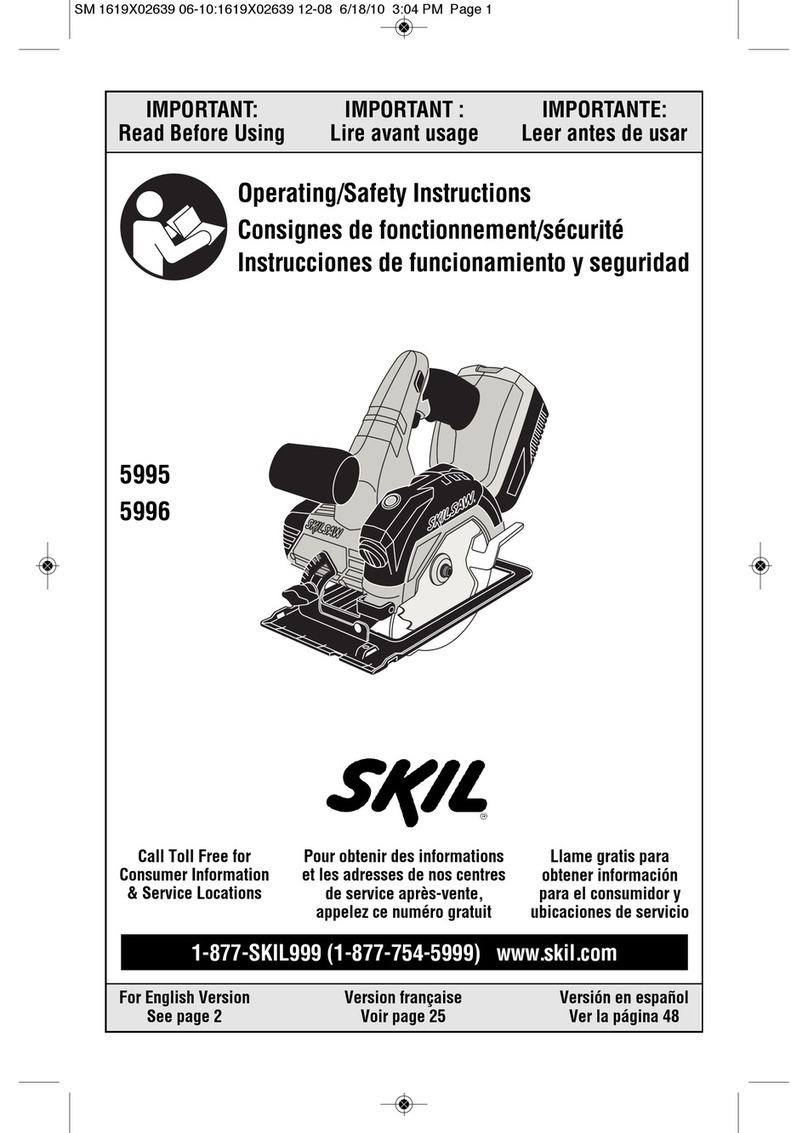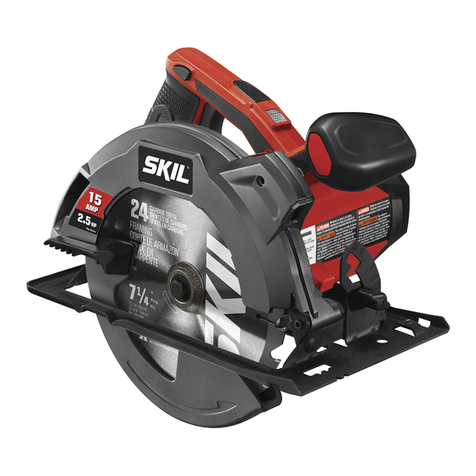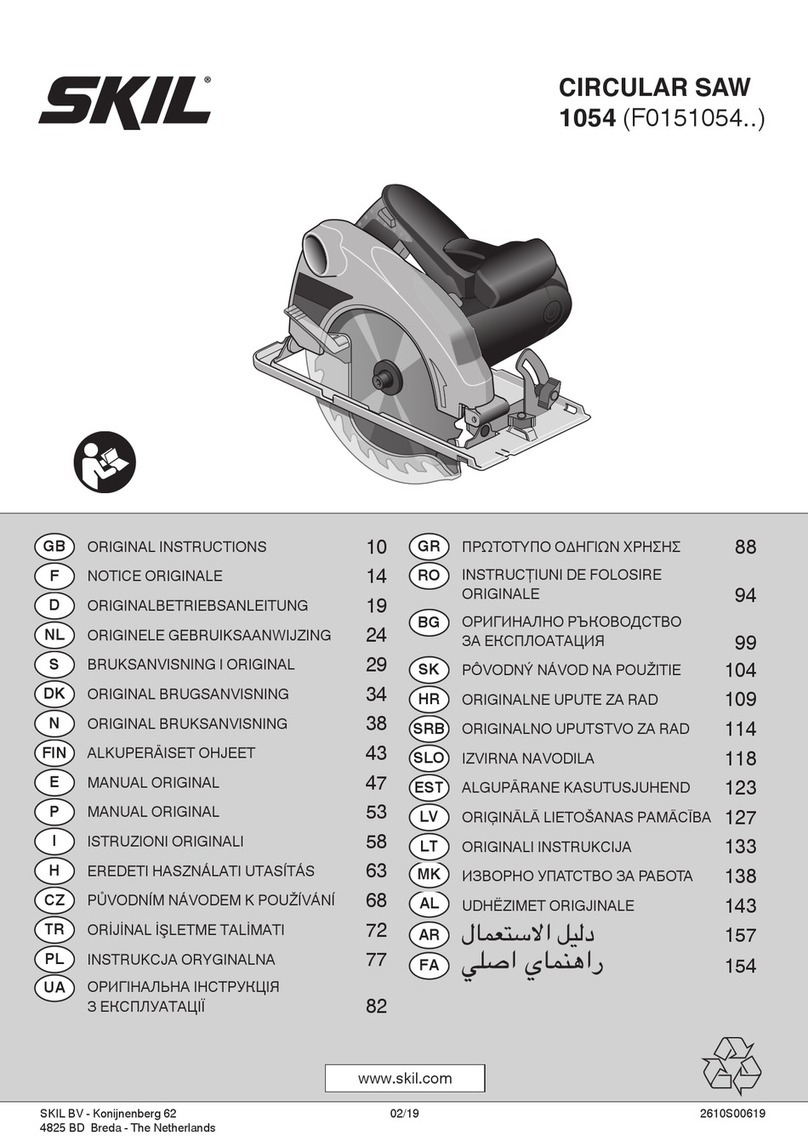
8
PERSONAL SAFETY
• In case of electrical or mechanical malfunction,
immediately switch o the tool and disconnect the plug
• This tool should not be used by people under the age of
16 years
• Do not work materials containing asbestos (asbestos
is considered carcinogenic)
• Dust from material such as paint containing lead, some
wood species, minerals and metal may be harmful
(contact with or inhalation of the dust may cause allergic
reactions and/or respiratory diseases to the operator or
bystanders); wear a dust mask and work with a dust
extraction device when connectable
• Certain kinds of dust are classied as carcinogenic
(such as oak and beech dust) especially in conjunction
with additives for wood conditioning; wear a dust
mask and work with a dust extraction device when
connectable
• Follow the dust-related national requirements for the
materials you want to work with
• Keep hands away from cutting area and the blade;
keep your second hand on barrel grip E 2(if both
hands are holding the saw, they can not be cut by the
blade)
• Do not reach underneath the workpiece (the proximity
of the blade to your hand is hidden from your sight)
• Never hold piece being cut in your hands or across
your leg (it is important to support the work properly
to minimise body exposure, blade binding, or loss of
control)
• Do not use a dull or damaged blade (bent blades can
break easily or cause kickback)
• Use protective gloves when removing the blade
from the tool (the saw blade may be hot after prolonged
use)
• Wear protective glasses and hearing protection
EXPLANATION OF SYMBOLS ON TOOL
3Read the instruction manual before use
4Double insulation (no earth wire required)
5Do not dispose of the tool together with household waste
material
WHEN CONNECTING NEW 3-PIN PLUG (U.K. ONLY):
• Do not connect the blue (= neutral) or brown (= live) wire
in the cord of this tool to the earth terminal of the plug
•If for any reason the old plug is cut o the cord of this tool,
it must be disposed of safely and not left unattended
USE
• Combined switch for on/o and speed control 67
-switch on/o the tool by pulling/releasing trigger A
-control the speed steplessly from zero to maximum by
putting less or more pressure on the trigger
• Mounting saw blade 8
! disconnect the plug
-turn blade clamp B in same direction as arrow C on tool
and hold it in that position
-insert blade (with teeth facing down or up) to full depth
-release blade clamp B
-push in and pull out blade to check whether it is locked
correctly
• Removing saw blade 8
-turn blade clamp B in same direction as arrow C on tool
and hold it in that position
-pull out blade
-release blade clamp B
power tool accidentally.
d) Store idle power tools out of the reach of children
and do not allow persons unfamiliar with the power
tool or these instructions to operate the power tool.
Power tools are dangerous in the hands of untrained
users.
e) Maintain power tools and accessories. Check for
misalignment or binding of moving parts, breakage
of parts and any other condition that may aect the
power tool’s operation. If damaged, have the power
tool repaired before use. Many accidents are caused
by poorly maintained power tools.
f) Keep cutting tools sharp and clean. Properly
maintained cutting tools with sharp cutting edges are less
likely to bind and are easier to control.
g) Use the power tool, accessories and tool bits etc.,
in accordance with these instructions, taking into
account the working conditions and the work to be
performed. Use of the power tool for operations dierent
from those intended could result in a hazardous situation.
h) Keep handles and grasping surfaces dry, clean
and free from oil and grease. Slippery handles and
grasping surfaces do not allow for safe handling and
control of the tool in unexpected situations.
5) SERVICE
a) Have your power tool serviced by a qualied repair
person using only identical replacement parts. This
will ensure that the safety of the power tool is maintained.
SAFETY INSTRUCTIONS FOR RECIPROCATING SAWS
• Hold the power tool by insulated gripping surfaces,
when performing an operation where the cutting
accessory may contact hidden wiring or its own
cord (cutting accessory contacting a “live” wire may
make exposed metal parts of the power tool “live” and
could give the operator an electric shock)
• Use clamps or another practical way to secure and
support the workpiece to a stable platform (holding
the workpiece by hand or against your body leaves it
unstable and may lead to loss of control)
ACCESSORIES
• SKIL can assure awless functioning of the tool only
when original accessories are used
• Use only accessories with an allowable speed matching
at least the highest no-load speed of the tool
BEFORE USE
• Always check that the supply voltage is the same as the
voltage indicated on the nameplate of the tool
• Avoid damage that can be caused by screws, nails and
other elements in your workpiece; remove them before
you start working
ELECTRICAL SAFETY
• Never use the tool when the cord is damaged; it must be
replaced by a specially prepared cord available through
the service organization.
• Use completely unrolled and safe extension cords with a
capacity of 16 Amps (U.K. 13 Amps)
• Use suitable detectors to nd hidden utility lines
or call the local utility company for assistance
(contact with electric lines can lead to re or electrical
shock; damaging a gas line can result in an explosion;
penetrating a water pipe will cause property damage or
an electrical shock)

